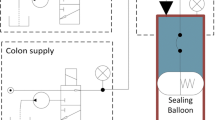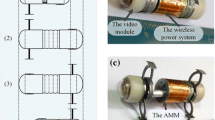Abstract
Colonoscopy is the most sensitive and specific means for detection of colon cancers and polyps. To make colonoscopy more effective several problems must be overcome including: pain associated with the procedure, the risk of perforation, and incomplete intubation colonoscopy. Technically, these problems are the result of loop formation during colonoscopy. Although, several solutions such as modifying the stiffness of the colonoscope, using an overtube and develo** image-guided instruments have been introduced to resolve the loo** problem, the results of these systems are not completely satisfactory. A new paradigm to overcome loop formation is proposed that is doctor-assistive colonoscopy. In this approach, the endoscopists performance is enhanced by providing using a kinetic model that provides information such as the shape of the scope, direction of the colon and forces exerted within certain sections. It is expected that with the help of this model, the endoscopist would be able to adjust the manipulation to avoid loop formation. In the present studies, the kinetic model is developed and validated using an ex vivo colonoscopy test-bed with a comprehensive kinematic and kinetic data collection. The model utilizes an established colon model based on animal tissue with position tracking sensors, contact force sensors for the intraluminal portion of the scope and a Colonoscopy Force Monitor for the external insertion tube.










Similar content being viewed by others
Abbreviations
- CFM:
-
Colonoscopy Force Monitor
- FEM:
-
Finite Element Method
- LCP:
-
Linear Complementarity Problem
- ELF:
-
Economical Load and Force
- ATC:
-
Ascension Technologies Corp
- DOF:
-
Degree of Freedom
- RMSE:
-
Root mean square error
- CV:
-
Coefficient of variation
- ANOVA:
-
Analysis of variance
References
Altenbach, J., H. Altenbach, and V. A. Eremeyev. On generalized Cosserat-type theories of plates and shells: a short review and bibliography. Arch. Appl. Mech. 80:73–92, 2010.
Chang, J., D. Shepherd, and J. J. Zhang. Cosserat-beam-based dynamic response modelling. Comput. Anim. Virtual Worlds 18(4–5):429–436, 2007.
Cheng, W. B., M. Moser, S. Kanagaratnam, and W. J. Zhang. Development of autonomous microrobotics in endoscopy. J. Med. Eng. Technol. 35:391–401, 2011.
Cheng, W. B., M. Moser, S. Kanagaratnam, and W. J. Zhang. Overview of upcoming advances in colonoscopy. Dig. Endosc. 24:1–6, 2012.
Cheng, W. B., M. Moser, S. Kanagaratnam, and W. J. Zhang. Analysis of and mathematical model insight into loop formation in colonoscopy. J. Eng. Med. 226:858–867, 2012.
Cheng, W. B., M. Moser, S. Kanagaratnam, and W. J. Zhang. Predication for relative motion of the colonoscope in colonoscopy. J. Mech. Med. Biol. 13:1–14, 2012.
Cheng, W. B., K. Y. Song, W. L. Luo, Z. Q. Qian, M. Moser, S. Kanagaratnam, and W. J. Zhang. Kinematical model and experimental validation for the colonoscope. J. Med. Biol. Eng. 2012. doi:10.5405/jmbe.1331.
Cheng, W. B., M. Moser, S. Kanagaratnam, and W. J. Zhang. Influence of physical property of colonoscope on loo** during colonoscopy. J. Med. Biol. Eng. 2012 doi:10.5405/jmbe.1139.
Dario, P., P. Ciarletta, A. Menciassi, and B. Kim. Modeling and experimental validation of the locomotion of endoscopic robots in the colon. Int. J. Robot. Res. 23:5540–5545, 2009.
Dequidt, J., C. Duriez, S. Cotin, and E. Kerrien. Towards interactive planning of coil embolization in brain aneurysms. MICCAI 12:377–385, 2009.
Duriez, C., C. Guebert, M. Marchal, S. Cotin, and L. Grisoni. Interactive simulation of flexible needle insertions based on constraint models. MICCAI 12:291–299, 2009.
Duriez, C., and A. Kheddar. Realistic haptic rendering of interacting deformable objects in virtual environments. IEEE Trans. Vis. Comput. Graph. 12:1–12, 2006.
Fung, Y. C. Biomechanics: mechanical properties of living tissues (2nd ed.). New York: Springer, pp. 278–279, 1993.
Gilardi, G., and I. Sharf. Literature survey of contact dynamics modeling. Mech. Mach. Theory 37:1213–1239, 2002.
Hellier, D., F. Albermni, B. Evans, H. D. Visser, C. Adam, and J. Passeger. Flexural and torsional rigidity of colonoscopes at room and body temperatures. J. Eng. Med. 225:389–399, 2011.
Hellier, D. Determination of colonoscope’s structure properties for interactive simulation of colonoscopy. Master Thesis, The University of Queensland, 2010.
Hong, M., S. Jung, M. Choi, and S. W. Welch. Fast volume preservation for a mass-spring system. IEEE Comput. Graph. Appl. 26(5):83–91, 2006.
Ikuta, K. Virtual endoscope system with force sensation. IEEE Int. Conf. Robotics Autom. 4:1715–1721, 1999.
Ikuta, K. Portable Virtual Endoscope System with Force and Visual Display for Insertion Training. MICCAI 1935:907–920, 2000.
Konings, M. K., E. B. van de Kraats, T. Alderliesten, and W. J. Niessen. Analytical guide wire motion algorithm for simulation of endovascular interventions. Med. Biol. Eng. Comput. 41(6):689–700, 2003.
Lenoir, J., S. Cotin, C. Duriez, and P. Neumnm. Physics-based models for catheter, guidewire and stent simulation. Stud. Health Technol. Inform. 119:305–310, 2006.
Louis, Y., L. Y. Korman, V. Egorov, S. Tsuryupa, B. Corbin, M. Anderson, N. Sarvazyan, and A. Sarvazyan. Characterization of forces applied by endoscopists during colonoscopy by using a wireless colonoscopy force monitor. Gastrointest. Endosc. 71(2):327–334, 2010.
Miller, K., and K. Chinzei. Constitutive modelling of brain tissue: experiment and theory. J. Biomech. 30:1115–1121, 1997.
Rem’ion, Y., J. M. Nourrit, and D. Gillard. Dynamic animation of spline like objects. J. Visual Comp. Animat. 11(1):17–26, 1999.
Shinya, M. Theories for mass-spring simulation in computer graphics: stability, costs and improvements. Ieice Trans. Inf. Syst. 88(4):767–774, 2005.
Spillmann, J., and M. Teschner. CORDE: cosserat rod elements for the dynamic simulation of one-dimensional elastic objects. Eurographics/ACM Siggraph Symposium on Computer Animation 2007, pp. 1–10.
Theetten, A., L. Grisoni, C. Andriot, and B. Barsky. Geometrically exact dynamic splines. Comput. Aided Des. 40:35–48, 2008.
Valentini, P. P., and E. Pennesti. Modeling elastic beams using dynamic splines. Multibody Syst. Dyn. 25:271–284, 2011.
Wu, X., M. Downes, T. Goktekin, and F. Tendick. Adaptive nonlinear finite elements for deformable body simulation using dynamic progressive meshes. Comput. Graph. Forum 20:349–358, 2001.
Zupan, D., and M. Saje. The three-dimensional beam theory: finite element formulation based on curvature. Comput. Struct. 81:1875–1888, 2003.
Acknowledgments
The first author wishes to acknowledge financial support received from China Scholarship Council for this research, and give special thanks to Dr. Christina Duriez for his technical support for this research. This research is partially supported by Shanghai Science and Technology Foundation through an international collaborative research funding (Research Funding No.: 12410709900). The authors acknowledge Artann Laboratories for providing CFM device for this research. Development of the CFM was supported by the Grant R44DK068936 from the National Institute Of Diabetes And Digestive And Kidney Diseases.
Conflict of interest
The authors declare that there is no conflict of interest.
Author information
Authors and Affiliations
Corresponding author
Additional information
Associate Editor Cheng Dong oversaw the review of this article.
Rights and permissions
About this article
Cite this article
Cheng, WB., Di, YY., Zhang, E.M. et al. Modeling and In Vitro Experimental Validation for Kinetics of the Colonoscope in Colonoscopy. Ann Biomed Eng 41, 1084–1093 (2013). https://doi.org/10.1007/s10439-013-0746-1
Received:
Accepted:
Published:
Issue Date:
DOI: https://doi.org/10.1007/s10439-013-0746-1




